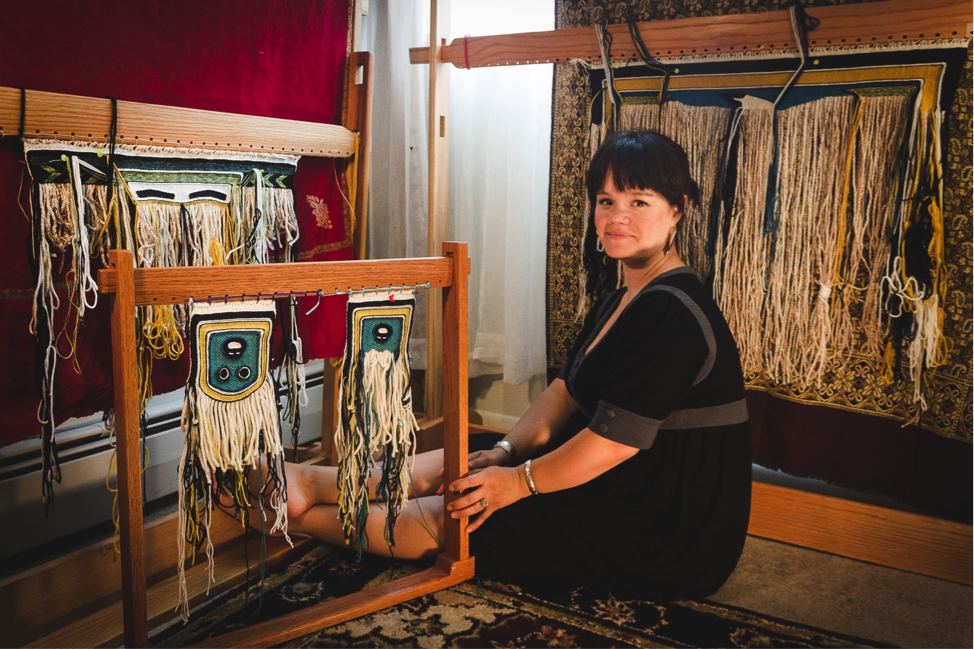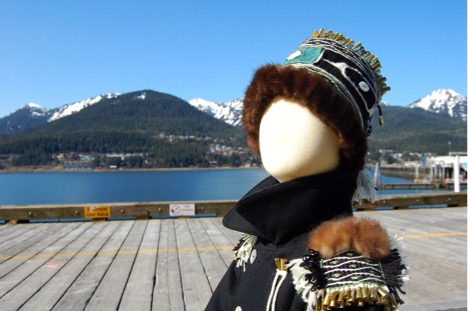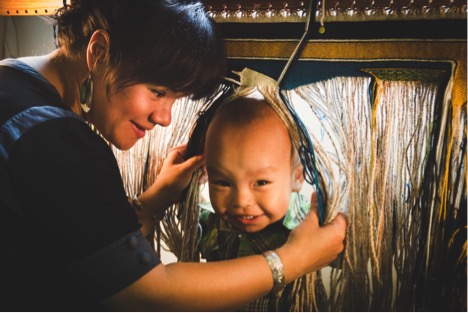Artists in Alaska: Chilkat Artist Lily Hope on Working in Juneau

We partnered with Rasmuson Foundation to bring career advancement courses to artists in Alaska. Lily Hope, a Native Alaskan artist who specializes in Chilkat weaving, shares insight on her field and working in Juneau.

Lily Hope in her home studio with Chilkat robe, apron, and leggings in-progress. Photo: Freddie Munoz
Alex Teplitzky: Hi Lily! Tell me about yourself and working and living in Alaska. Is it challenging or rewarding? Both?
Lily Hope: I’m an Alaskan Native artist of the T’akdeintaan Clan. I’m a Naaxein—Chilkat and Yéil Koowú—Ravenstail weaver and teacher, mother of five, and wife to poet and storyteller, Ishmael Hope. Chilkat robes use modified Northwest Coast form line, and I weave them by hand on an upright frame with no tools other than a tapestry needle to tuck in braids. Chilkat weaving is the only textile in the world where we can weave a perfect circle. Ravenstail pre-dates Chilkat, woven on the same looms, but utilizing more basketry and geometric designs, with more varying techniques.
We live in Juneau, Alaska. Some people say to live in this climate you either have to drink a lot of alcohol, or meditate often, but I find that consistently making art and creating art together has the same effect. We artists feel the greys less often.
The rewards living and making art in Alaska are many. We have nature, each other, and all of us get creative in supporting one another.
The mountains rise out of the water, and the accessible Mendenhall Glacier is only a 15-minute drive from home. We can immerse in nature’s inspiration by stepping out our back door. We Alaskans also serve each other well. Maybe it’s the isolation (you can only get to Juneau by plane or boat), or maybe it’s the extended days of grey. My dear artist friend, SueAnn Randall, says that Alaska has been this way since at least the early 70s, before Fred Meyer or Walmart: “We stepped up to help whenever anyone asked, because we knew at some point it would be our turn to ask for help.” Likewise, when someone has a creative idea, people jump on board to assist in bringing that project to fruition, or back the artist however they need. Another friend, whose day job is in the State House, is engineering a way to hinge and collapse my seven-foot loom, so I can board airplanes without dragging a loom-filled ski bag. Alaska drives us to think outside the box (stores) and help each other. It’s the best place to live and create art.
This has been my most productive summer and fall thanks to implementing ideas learned with Creative Capital.
In contrast, the biggest challenge in weaving Ravenstail and Chilkat robes in Southeast Alaska is shipping materials. It’s a pain, as many shippers don’t recognize Alaska as part of the USA, and others charge more to ship to Alaska, even though the United States Post Office offers flat rate shipping, which applies to AK. I ask for flat rate USPS whenever I can.

Little Watchman, Chilkat and Ravenstail child ensemble. Lily Hope © 2014. Photo: Deanna Lampe
Alex: What did you learn in Creative Capital’s professional development course you recently took?
Lily: As part of our Rasmuson awards this past summer, we were asked if we could attend a one-day workshop with Creative Capital. Thank goodness I made the time to do it. This has been my most productive summer and fall thanks to implementing ideas learned with Creative Capital.
What have I done differently? I wrote a mission statement. A bold, impossible, exciting goal, that I’m jazzed to wake up for each morning. My dream is to make Chilkat and Ravenstail weavings recognizable worldwide, so every person who sees an image of either style robe/textile, they’ll say, “I know what that is, and where they’re made.”
After the workshop, I’m also constantly asking myself if the next project/class fits at least three of these four things:
- Does it compensate you well?
- Does it teach you something?
- Does it help your art/mission?
- Is it socially significant, is it just?
Using this criteria, did I teach seven weaving classes this summer? Yes. Did I complete a Chilkat robe for a museum? Yes. Did I accept another 18-month commission? Yes. Did I get a grant to do a class for 20 students on how to weave the most daunting shape in Chilkat weaving: the Chilkat Face? Yes. Yes, I did. Did I use this checklist to turn down a once-in-a-lifetime opportunity to apprentice under another endangered art form, with a Master artist? Yes.
Did I not accept a risky “make this art, and then we’ll apply for a grant to pay you for it” offer? Yes.
I can’t wait to see what I can say yes to in the coming year. And how easy it is to say no, now that I understand where I’m going and what parameters to use.
If you see the opportunity to take a class with Creative Capital, do it!

“Me and one of my five kiddos, Mr. Louis William Hope,” says Lily. Photo: Freddie Munoz
Alex: Your Rasmuson Individual Artist Award helped you go to Vancouver for research on your practice. How will you use this new knowledge back home in Alaska?
Lily: In August, using my Rasmuson award, I completed the first part of my grant proposal, by studying Chilkat robes and textiles at the Museum of Anthropology, in Vancouver, British Columbia. I got to inspect braids up close, and flip robes over to see how other weavers construct their fine Chilkat shapes. One of my students in Vancouver joined me, on one of the mornings. It was helpful to have another person to bounce ideas around. We also inspected a robe labeled “Chilkat” that was obviously not woven in Chilkat technique, but used some of the shapes. We had a conversation with the museum staff, asking them to please edit their object description to reflect that the robe is woven with Chilkat shapes, but to not call it a Chilkat robe, as this is inaccurate and misleading to other researchers.
Since coming home with my photos and knowledge of how weavers worked the fibers in to fine points hundreds of years ago, I’m excited to finish the second half of my Rasmuson grant, to connect with a master weaver to refine the shapes I selected to perfect, and then start my next robe, which goes on the loom on November 1 this year.
I’m grateful to the Rasmuson Foundation for their support, and for the team from Creative Capital, who’ve helped shape my most artistically and financially satisfying year.
Lily Hope’s work is on view in the permanent collection at the Portland Art Museum. Check out her website to learn more about her work.
